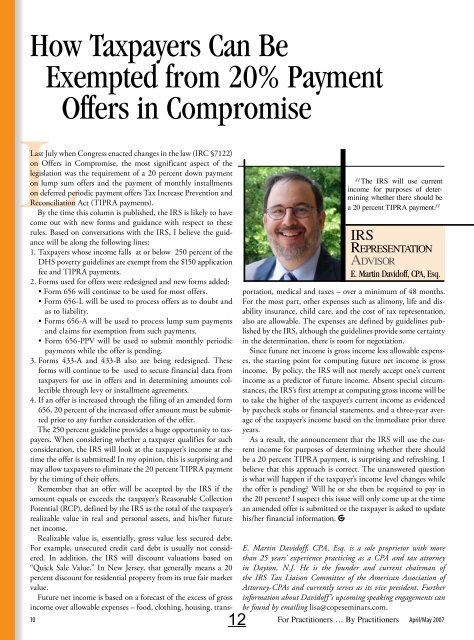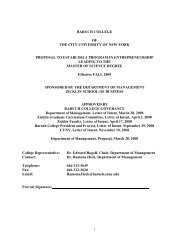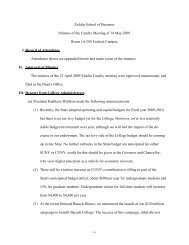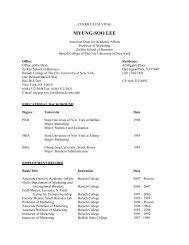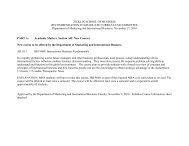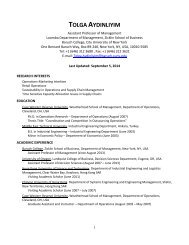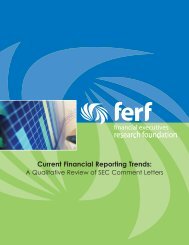Tax Seminar #3 – December 3 2012
Workbook - Zicklin School of Business
Workbook - Zicklin School of Business
Create successful ePaper yourself
Turn your PDF publications into a flip-book with our unique Google optimized e-Paper software.
How <strong>Tax</strong>payers Can Be<br />
Exempted from 20% Payment<br />
Offers in Compromise<br />
12<br />
The IRS will use current<br />
income “ for purposes of determining<br />
whether there should be<br />
a 20 percent TIPRA payment.<br />
”<br />
IRS<br />
Representation<br />
Advisor<br />
E. Martin Davidoff, CPA, Esq.<br />
L<br />
Last July when Congress enacted changes in the law (IRC §7122)<br />
on Offers in Compromise, the most significant aspect of the<br />
legislation was the requirement of a 20 percent down payment<br />
on lump sum offers and the payment of monthly installments<br />
on deferred periodic payment offers <strong>Tax</strong> Increase Prevention and<br />
Reconciliation Act (TIPRA payments).<br />
By the time this column is published, the IRS is likely to have<br />
come out with new forms and guidance with respect to these<br />
rules. Based on conversations with the IRS, I believe the guidance<br />
will be along the following lines:<br />
1. <strong>Tax</strong>payers whose income falls at or below 250 percent of the<br />
DHS poverty guidelines are exempt from the $150 application<br />
fee and TIPRA payments.<br />
2. Forms used for offers were redesigned and new forms added:<br />
• Form 656 will continue to be used for most offers.<br />
• Form 656-L will be used to process offers as to doubt and<br />
as to liability.<br />
• Forms 656-A will be used to process lump sum payments<br />
and claims for exemption from such payments.<br />
• Form 656-PPV will be used to submit monthly periodic<br />
payments while the offer is pending.<br />
3. Forms 433-A and 433-B also are being redesigned. These<br />
forms will continue to be used to secure financial data from<br />
taxpayers for use in offers and in determining amounts collectible<br />
through levy or installment agreements.<br />
4. If an offer is increased through the filing of an amended form<br />
656, 20 percent of the increased offer amount must be submitted<br />
prior to any further consideration of the offer.<br />
The 250 percent guideline provides a huge opportunity to taxpayers.<br />
When considering whether a taxpayer qualifies for such<br />
consideration, the IRS will look at the taxpayer’s income at the<br />
time the offer is submitted! In my opinion, this is surprising and<br />
may allow taxpayers to eliminate the 20 percent TIPRA payment<br />
by the timing of their offers.<br />
Remember that an offer will be accepted by the IRS if the<br />
amount equals or exceeds the taxpayer’s Reasonable Collection<br />
Potential (RCP), defined by the IRS as the total of the taxpayer’s<br />
realizable value in real and personal assets, and his/her future<br />
net income.<br />
Realizable value is, essentially, gross value less secured debt.<br />
For example, unsecured credit card debt is usually not considered.<br />
In addition, the IRS will discount valuations based on<br />
“Quick Sale Value.” In New Jersey, that generally means a 20<br />
percent discount for residential property from its true fair market<br />
value.<br />
Future net income is based on a forecast of the excess of gross<br />
income over allowable expenses <strong>–</strong> food, clothing, housing, transportation,<br />
medical and taxes <strong>–</strong> over a minimum of 48 months.<br />
For the most part, other expenses such as alimony, life and disability<br />
insurance, child care, and the cost of tax representation,<br />
also are allowable. The expenses are defined by guidelines published<br />
by the IRS, although the guidelines provide some certainty<br />
in the determination, there is room for negotiation.<br />
Since future net income is gross income less allowable expenses,<br />
the starting point for computing future net income is gross<br />
income. By policy, the IRS will not merely accept one’s current<br />
income as a predictor of future income. Absent special circumstances,<br />
the IRS’s first attempt at computing gross income will be<br />
to take the higher of the taxpayer’s current income as evidenced<br />
by paycheck stubs or financial statements, and a three-year average<br />
of the taxpayer’s income based on the immediate prior three<br />
years.<br />
As a result, the announcement that the IRS will use the current<br />
income for purposes of determining whether there should<br />
be a 20 percent TIPRA payment, is surprising and refreshing. I<br />
believe that this approach is correct. The unanswered question<br />
is what will happen if the taxpayer’s income level changes while<br />
the offer is pending? Will he or she then be required to pay in<br />
the 20 percent? I suspect this issue will only come up at the time<br />
an amended offer is submitted or the taxpayer is asked to update<br />
his/her financial information.<br />
E. Martin Davidoff, CPA, Esq. is a sole proprietor with more<br />
than 25 years’ experience practicing as a CPA and tax attorney<br />
in Dayton, N.J. He is the founder and current chairman of<br />
the IRS <strong>Tax</strong> Liaison Committee of the American Association of<br />
Attorney-CPAs and currently serves as its vice president. Further<br />
information about Davidoff’s upcoming speaking engagements can<br />
be found by emailing lisa@copeseminars.com.<br />
10 For Practitioners … By Practitioners April/May 2007


